Wai Lam
A Unified Multi-task Learning Framework for Multi-goal Conversational Recommender Systems
Apr 14, 2022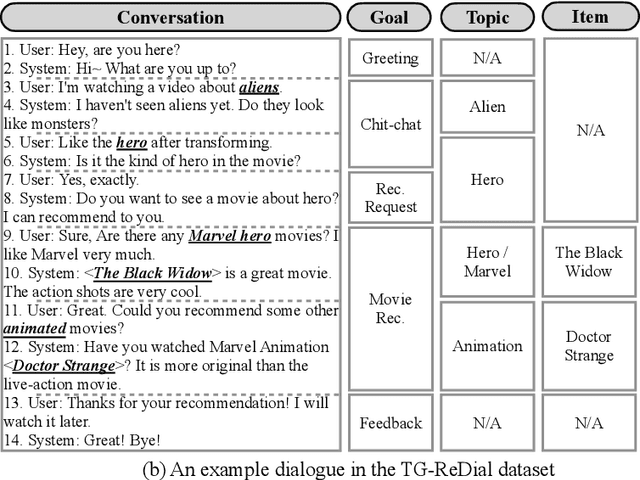

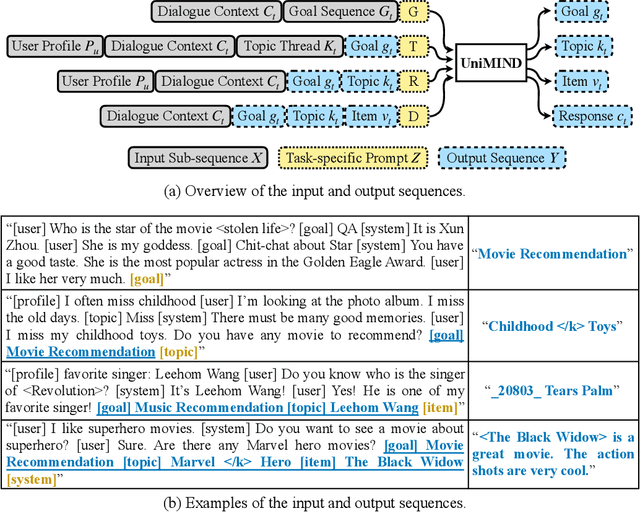
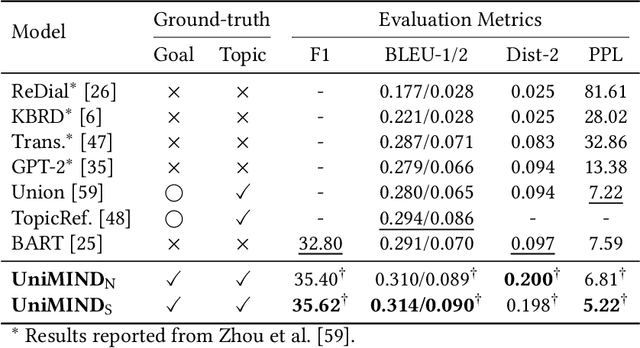
Abstract:Recent years witnessed several advances in developing multi-goal conversational recommender systems (MG-CRS) that can proactively attract users' interests and naturally lead user-engaged dialogues with multiple conversational goals and diverse topics. Four tasks are often involved in MG-CRS, including Goal Planning, Topic Prediction, Item Recommendation, and Response Generation. Most existing studies address only some of these tasks. To handle the whole problem of MG-CRS, modularized frameworks are adopted where each task is tackled independently without considering their interdependencies. In this work, we propose a novel Unified MultI-goal conversational recommeNDer system, namely UniMIND. In specific, we unify these four tasks with different formulations into the same sequence-to-sequence (Seq2Seq) paradigm. Prompt-based learning strategies are investigated to endow the unified model with the capability of multi-task learning. Finally, the overall learning and inference procedure consists of three stages, including multi-task learning, prompt-based tuning, and inference. Experimental results on two MG-CRS benchmarks (DuRecDial and TG-ReDial) show that UniMIND achieves state-of-the-art performance on all tasks with a unified model. Extensive analyses and discussions are provided for shedding some new perspectives for MG-CRS.
Parameter-Efficient Tuning by Manipulating Hidden States of Pretrained Language Models For Classification Tasks
Apr 13, 2022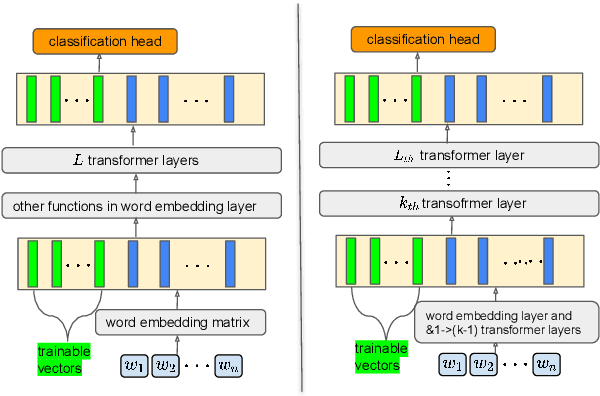
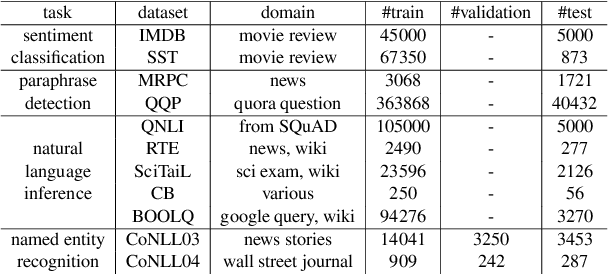
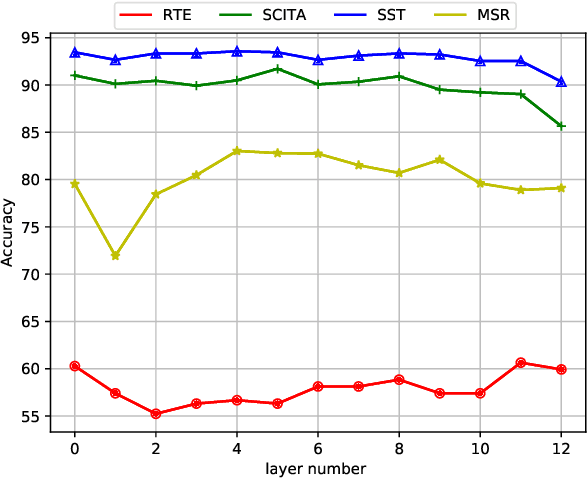
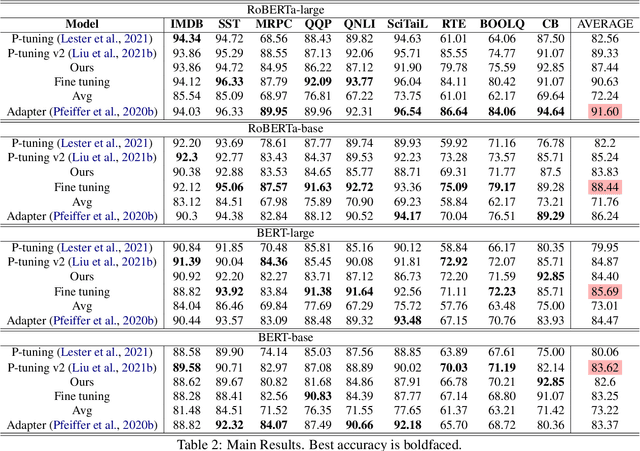
Abstract:Parameter-efficient tuning aims to distill knowledge for downstream tasks by optimizing a few introduced parameters while freezing the pretrained language models (PLMs). Continuous prompt tuning which prepends a few trainable vectors to the embeddings of input is one of these methods and has drawn much attention due to its effectiveness and efficiency. This family of methods can be illustrated as exerting nonlinear transformations of hidden states inside PLMs. However, a natural question is ignored: can the hidden states be directly used for classification without changing them? In this paper, we aim to answer this question by proposing a simple tuning method which only introduces three trainable vectors. Firstly, we integrate all layers hidden states using the introduced vectors. And then, we input the integrated hidden state(s) to a task-specific linear classifier to predict categories. This scheme is similar to the way ELMo utilises hidden states except that they feed the hidden states to LSTM-based models. Although our proposed tuning scheme is simple, it achieves comparable performance with prompt tuning methods like P-tuning and P-tuning v2, verifying that original hidden states do contain useful information for classification tasks. Moreover, our method has an advantage over prompt tuning in terms of time and the number of parameters.
A Survey on Aspect-Based Sentiment Analysis: Tasks, Methods, and Challenges
Mar 02, 2022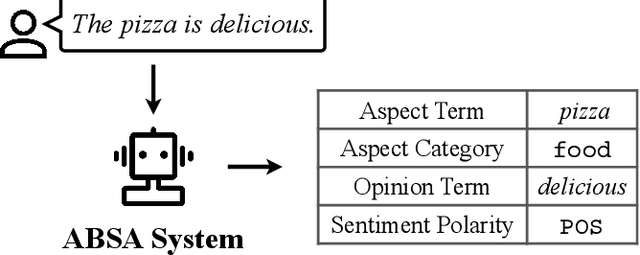

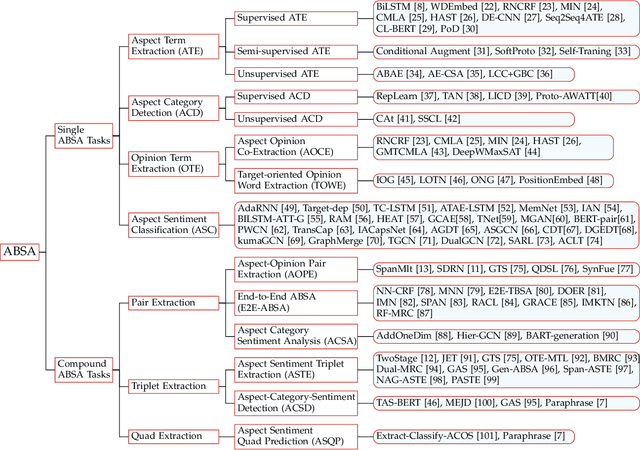
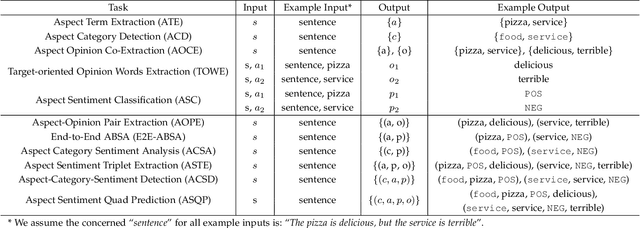
Abstract:As an important fine-grained sentiment analysis problem, aspect-based sentiment analysis (ABSA), aiming to analyze and understand people's opinions at the aspect level, has been attracting considerable interest in the last decade. To handle ABSA in different scenarios, various tasks have been introduced for analyzing different sentiment elements and their relations, including the aspect term, aspect category, opinion term, and sentiment polarity. Unlike early ABSA works focusing on a single sentiment element, many compound ABSA tasks involving multiple elements have been studied in recent years for capturing more complete aspect-level sentiment information. However, a systematic review of various ABSA tasks and their corresponding solutions is still lacking, which we aim to fill in this survey. More specifically, we provide a new taxonomy for ABSA which organizes existing studies from the axes of concerned sentiment elements, with an emphasis on recent advances of compound ABSA tasks. From the perspective of solutions, we summarize the utilization of pre-trained language models for ABSA, which improved the performance of ABSA to a new stage. Besides, techniques for building more practical ABSA systems in cross-domain/lingual scenarios are discussed. Finally, we review some emerging topics and discuss some open challenges to outlook potential future directions of ABSA.
Improving Lexical Embeddings for Robust Question Answering
Feb 28, 2022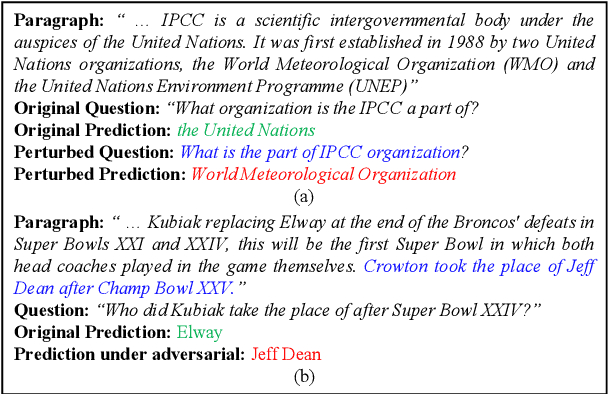
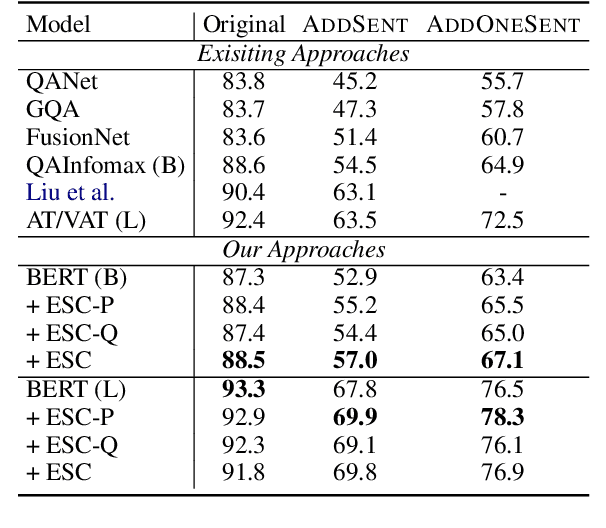
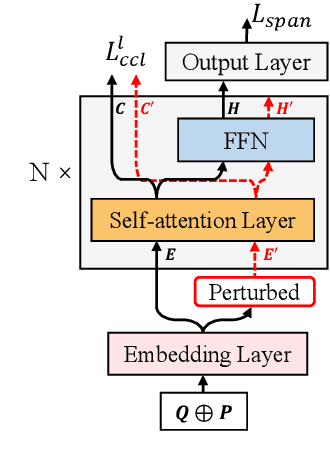
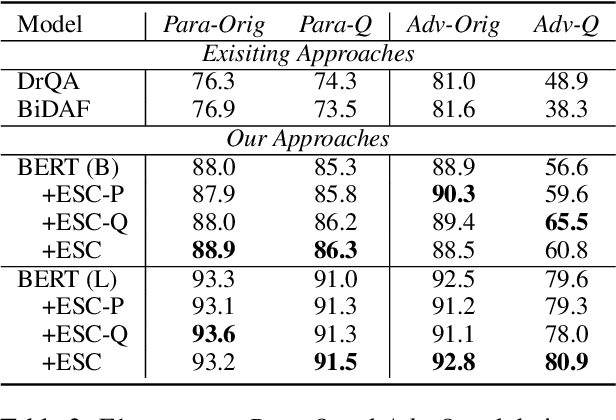
Abstract:Recent techniques in Question Answering (QA) have gained remarkable performance improvement with some QA models even surpassed human performance. However, the ability of these models in truly understanding the language still remains dubious and the models are revealing limitations when facing adversarial examples. To strengthen the robustness of QA models and their generalization ability, we propose a representation Enhancement via Semantic and Context constraints (ESC) approach to improve the robustness of lexical embeddings. Specifically, we insert perturbations with semantic constraints and train enhanced contextual representations via a context-constraint loss to better distinguish the context clues for the correct answer. Experimental results show that our approach gains significant robustness improvement on four adversarial test sets.
User Satisfaction Estimation with Sequential Dialogue Act Modeling in Goal-oriented Conversational Systems
Feb 07, 2022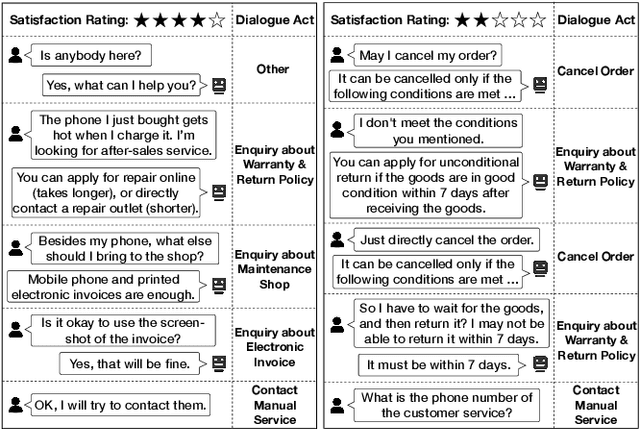
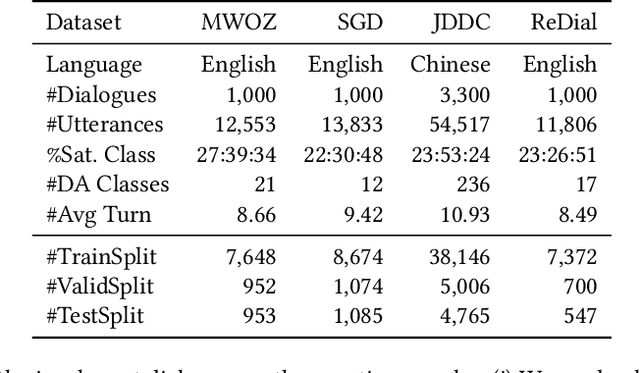
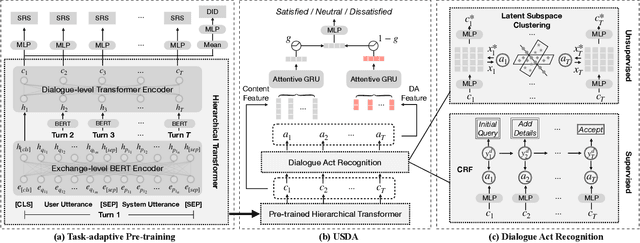
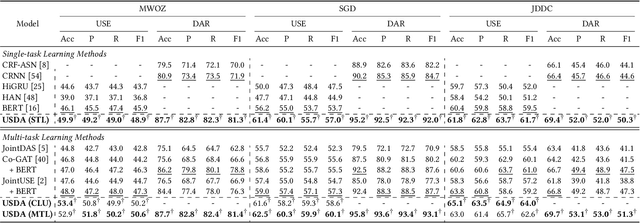
Abstract:User Satisfaction Estimation (USE) is an important yet challenging task in goal-oriented conversational systems. Whether the user is satisfied with the system largely depends on the fulfillment of the user's needs, which can be implicitly reflected by users' dialogue acts. However, existing studies often neglect the sequential transitions of dialogue act or rely heavily on annotated dialogue act labels when utilizing dialogue acts to facilitate USE. In this paper, we propose a novel framework, namely USDA, to incorporate the sequential dynamics of dialogue acts for predicting user satisfaction, by jointly learning User Satisfaction Estimation and Dialogue Act Recognition tasks. In specific, we first employ a Hierarchical Transformer to encode the whole dialogue context, with two task-adaptive pre-training strategies to be a second-phase in-domain pre-training for enhancing the dialogue modeling ability. In terms of the availability of dialogue act labels, we further develop two variants of USDA to capture the dialogue act information in either supervised or unsupervised manners. Finally, USDA leverages the sequential transitions of both content and act features in the dialogue to predict the user satisfaction. Experimental results on four benchmark goal-oriented dialogue datasets across different applications show that the proposed method substantially and consistently outperforms existing methods on USE, and validate the important role of dialogue act sequences in USE.
Towards Personalized Answer Generation in E-Commerce via Multi-Perspective Preference Modeling
Dec 27, 2021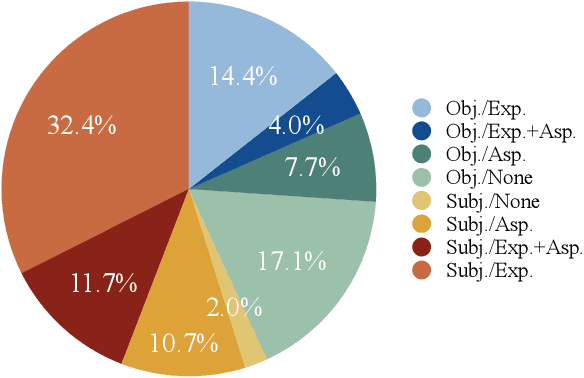
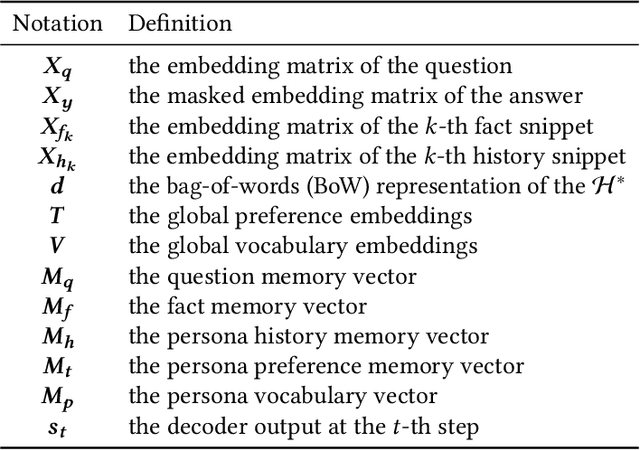
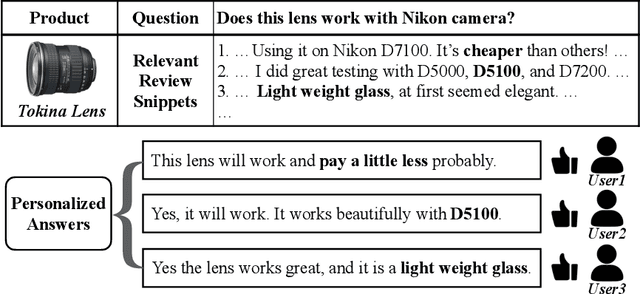

Abstract:Recently, Product Question Answering (PQA) on E-Commerce platforms has attracted increasing attention as it can act as an intelligent online shopping assistant and improve the customer shopping experience. Its key function, automatic answer generation for product-related questions, has been studied by aiming to generate content-preserving while question-related answers. However, an important characteristic of PQA, i.e., personalization, is neglected by existing methods. It is insufficient to provide the same "completely summarized" answer to all customers, since many customers are more willing to see personalized answers with customized information only for themselves, by taking into consideration their own preferences towards product aspects or information needs. To tackle this challenge, we propose a novel Personalized Answer GEneration method (PAGE) with multi-perspective preference modeling, which explores historical user-generated contents to model user preference for generating personalized answers in PQA. Specifically, we first retrieve question-related user history as external knowledge to model knowledge-level user preference. Then we leverage Gaussian Softmax distribution model to capture latent aspect-level user preference. Finally, we develop a persona-aware pointer network to generate personalized answers in terms of both content and style by utilizing personal user preference and dynamic user vocabulary. Experimental results on real-world E-Commerce QA datasets demonstrate that the proposed method outperforms existing methods by generating informative and customized answers, and show that answer generation in E-Commerce can benefit from personalization.
Partner Personas Generation for Diverse Dialogue Generation
Nov 27, 2021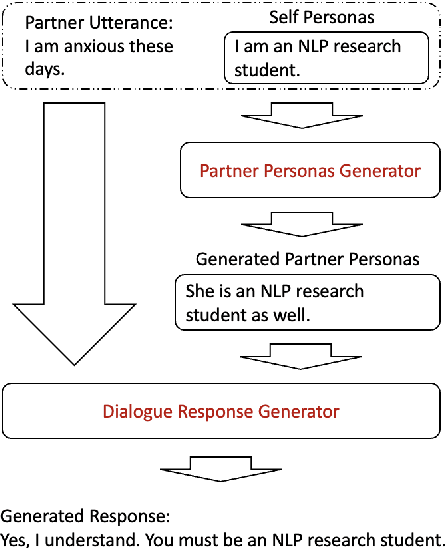


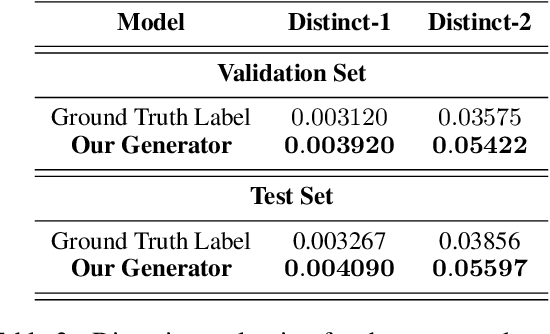
Abstract:Incorporating personas information allows diverse and engaging responses in dialogue response generation. Unfortunately, prior works have primarily focused on self personas and have overlooked the value of partner personas. Moreover, in practical applications, the availability of ground truth partner personas is often not the case. This paper attempts to tackle these issues by offering a novel framework that leverages automatic partner personas generation to enhance the succeeding dialogue generation. We incorporate reinforcement learning with a dedicatedly designed critic network for reward judgement. Experimental results from both automatic and human evaluation demonstrate a) Our framework is capable of generating relevant, informative and coherent partner personas, even compared to the ground truth partner personas. b) Generated partner personas enhance the succeeding response generation, thus surpassing our baselines and comparison model when partner personas are missing during the inference stage. c) Our framework generates responses that are more informative and engaging than our baseline conditioned on the ground truth partner personas during inference. d) Our dedicatedly designed critic network reinforces our framework effectively. Finally, our framework gives better explainability and reduces the demands for external databases for partner personas.
Sentiment Analysis of Fashion Related Posts in Social Media
Nov 15, 2021
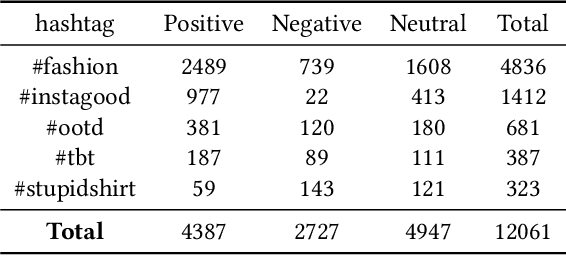
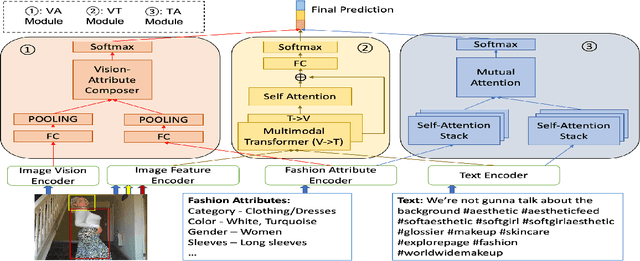
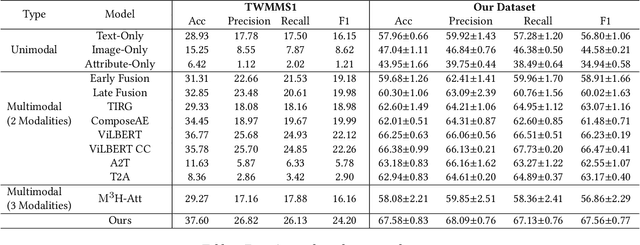
Abstract:The role of social media in fashion industry has been blooming as the years have continued on. In this work, we investigate sentiment analysis for fashion related posts in social media platforms. There are two main challenges of this task. On the first place, information of different modalities must be jointly considered to make the final predictions. On the second place, some unique fashion related attributes should be taken into account. While most existing works focus on traditional multimodal sentiment analysis, they always fail to exploit the fashion related attributes in this task. We propose a novel framework that jointly leverages the image vision, post text, as well as fashion attribute modality to determine the sentiment category. One characteristic of our model is that it extracts fashion attributes and integrates them with the image vision information for effective representation. Furthermore, it exploits the mutual relationship between the fashion attributes and the post texts via a mutual attention mechanism. Since there is no existing dataset suitable for this task, we prepare a large-scale sentiment analysis dataset of over 12k fashion related social media posts. Extensive experiments are conducted to demonstrate the effectiveness of our model.
Multilingual AMR Parsing with Noisy Knowledge Distillation
Oct 14, 2021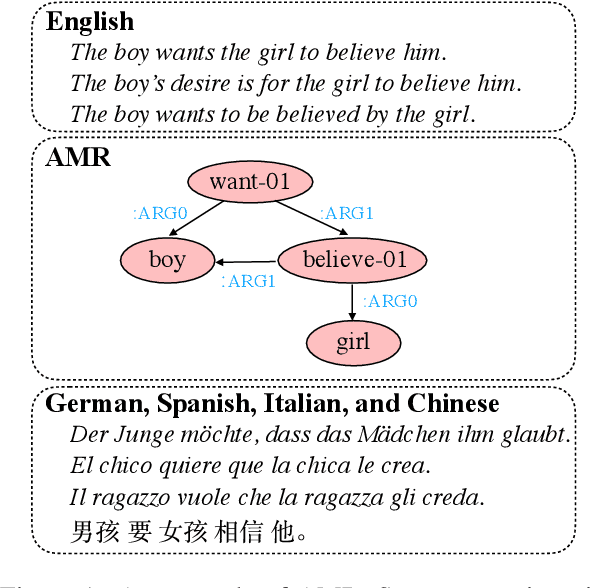
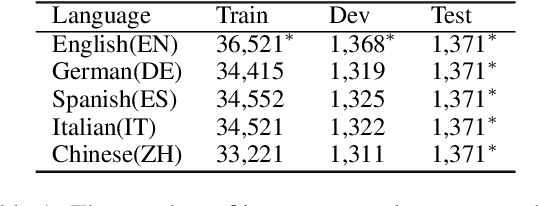
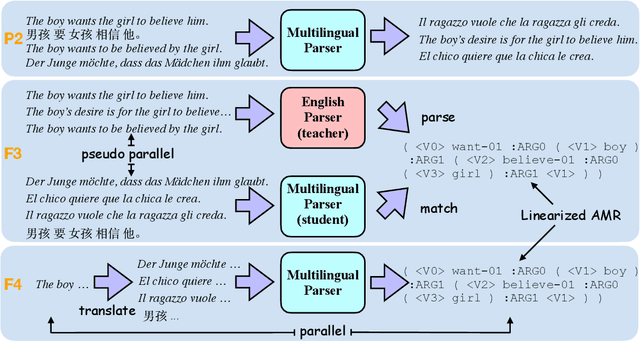
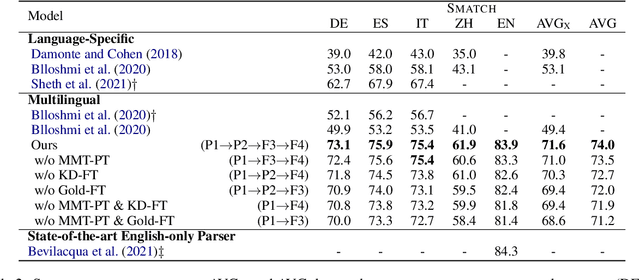
Abstract:We study multilingual AMR parsing from the perspective of knowledge distillation, where the aim is to learn and improve a multilingual AMR parser by using an existing English parser as its teacher. We constrain our exploration in a strict multilingual setting: there is but one model to parse all different languages including English. We identify that noisy input and precise output are the key to successful distillation. Together with extensive pre-training, we obtain an AMR parser whose performances surpass all previously published results on four different foreign languages, including German, Spanish, Italian, and Chinese, by large margins (up to 18.8 \textsc{Smatch} points on Chinese and on average 11.3 \textsc{Smatch} points). Our parser also achieves comparable performance on English to the latest state-of-the-art English-only parser.
Aspect Sentiment Quad Prediction as Paraphrase Generation
Oct 02, 2021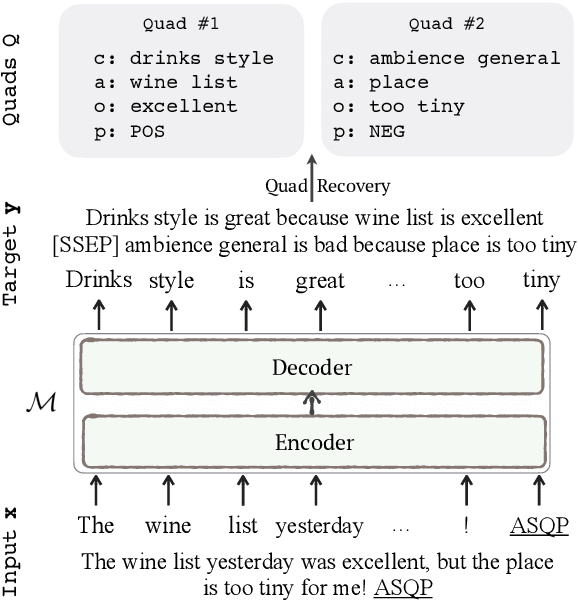
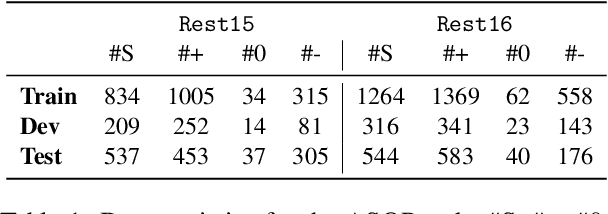
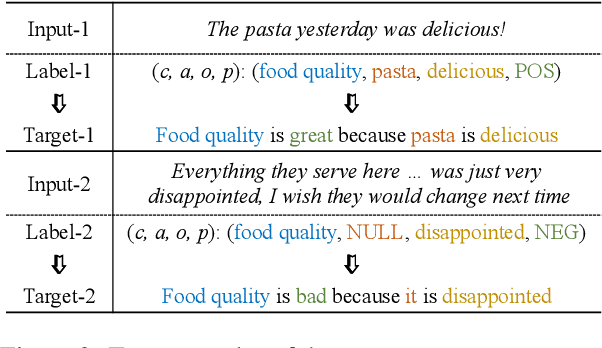
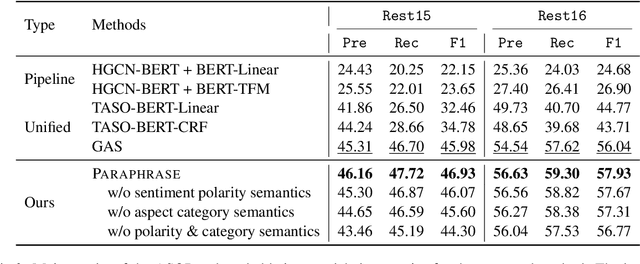
Abstract:Aspect-based sentiment analysis (ABSA) has been extensively studied in recent years, which typically involves four fundamental sentiment elements, including the aspect category, aspect term, opinion term, and sentiment polarity. Existing studies usually consider the detection of partial sentiment elements, instead of predicting the four elements in one shot. In this work, we introduce the Aspect Sentiment Quad Prediction (ASQP) task, aiming to jointly detect all sentiment elements in quads for a given opinionated sentence, which can reveal a more comprehensive and complete aspect-level sentiment structure. We further propose a novel \textsc{Paraphrase} modeling paradigm to cast the ASQP task to a paraphrase generation process. On one hand, the generation formulation allows solving ASQP in an end-to-end manner, alleviating the potential error propagation in the pipeline solution. On the other hand, the semantics of the sentiment elements can be fully exploited by learning to generate them in the natural language form. Extensive experiments on benchmark datasets show the superiority of our proposed method and the capacity of cross-task transfer with the proposed unified \textsc{Paraphrase} modeling framework.
 Add to Chrome
Add to Chrome Add to Firefox
Add to Firefox Add to Edge
Add to Edge